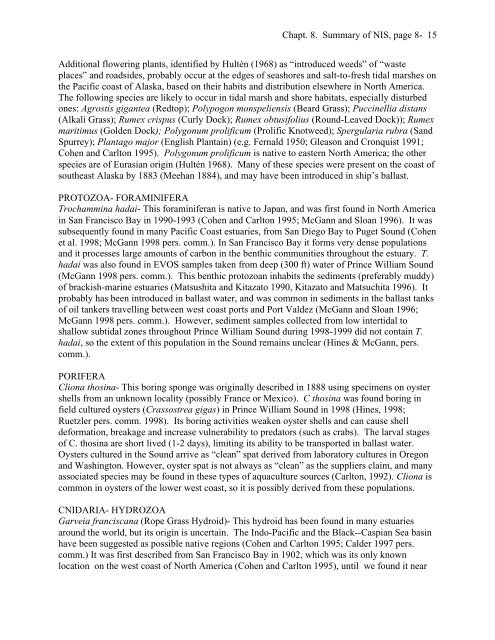Biological Invasions of Cold-Water Coastal Ecosystems - Aquatic ...
Biological Invasions of Cold-Water Coastal Ecosystems - Aquatic ...
Biological Invasions of Cold-Water Coastal Ecosystems - Aquatic ...
You also want an ePaper? Increase the reach of your titles
YUMPU automatically turns print PDFs into web optimized ePapers that Google loves.
Chapt. 8. Summary <strong>of</strong> NIS, page 8- 15<br />
Additional flowering plants, identified by Hultén (1968) as “introduced weeds” <strong>of</strong> “waste<br />
places” and roadsides, probably occur at the edges <strong>of</strong> seashores and salt-to-fresh tidal marshes on<br />
the Pacific coast <strong>of</strong> Alaska, based on their habits and distribution elsewhere in North America.<br />
The following species are likely to occur in tidal marsh and shore habitats, especially disturbed<br />
ones: Agrostis gigantea (Redtop); Polypogon monspeliensis (Beard Grass); Puccinellia distans<br />
(Alkali Grass); Rumex crispus (Curly Dock); Rumex obtusifolius (Round-Leaved Dock)); Rumex<br />
maritimus (Golden Dock); Polygonum prolificum (Prolific Knotweed); Spergularia rubra (Sand<br />
Spurrey); Plantago major (English Plantain) (e.g. Fernald 1950; Gleason and Cronquist 1991;<br />
Cohen and Carlton 1995). Polygonum prolificum is native to eastern North America; the other<br />
species are <strong>of</strong> Eurasian origin (Hultén 1968). Many <strong>of</strong> these species were present on the coast <strong>of</strong><br />
southeast Alaska by 1883 (Meehan 1884), and may have been introduced in ship’s ballast.<br />
PROTOZOA- FORAMINIFERA<br />
Trochammina hadai- This foraminiferan is native to Japan, and was first found in North America<br />
in San Francisco Bay in 1990-1993 (Cohen and Carlton 1995; McGann and Sloan 1996). It was<br />
subsequently found in many Pacific Coast estuaries, from San Diego Bay to Puget Sound (Cohen<br />
et al. 1998; McGann 1998 pers. comm.). In San Francisco Bay it forms very dense populations<br />
and it processes large amounts <strong>of</strong> carbon in the benthic communities throughout the estuary. T.<br />
hadai was also found in EVOS samples taken from deep (300 ft) water <strong>of</strong> Prince William Sound<br />
(McGann 1998 pers. comm.). This benthic protozoan inhabits the sediments (preferably muddy)<br />
<strong>of</strong> brackish-marine estuaries (Matsushita and Kitazato 1990, Kitazato and Matsuchita 1996). It<br />
probably has been introduced in ballast water, and was common in sediments in the ballast tanks<br />
<strong>of</strong> oil tankers travelling between west coast ports and Port Valdez (McGann and Sloan 1996;<br />
McGann 1998 pers. comm.). However, sediment samples collected from low intertidal to<br />
shallow subtidal zones throughout Prince William Sound during 1998-1999 did not contain T.<br />
hadai, so the extent <strong>of</strong> this population in the Sound remains unclear (Hines & McGann, pers.<br />
comm.).<br />
PORIFERA<br />
Cliona thosina- This boring sponge was originally described in 1888 using specimens on oyster<br />
shells from an unknown locality (possibly France or Mexico). C thosina was found boring in<br />
field cultured oysters (Crassostrea gigas) in Prince William Sound in 1998 (Hines, 1998;<br />
Ruetzler pers. comm. 1998). Its boring activities weaken oyster shells and can cause shell<br />
deformation, breakage and increase vulnerability to predators (such as crabs). The larval stages<br />
<strong>of</strong> C. thosina are short lived (1-2 days), limiting its ability to be transported in ballast water.<br />
Oysters cultured in the Sound arrive as “clean” spat derived from laboratory cultures in Oregon<br />
and Washington. However, oyster spat is not always as “clean” as the suppliers claim, and many<br />
associated species may be found in these types <strong>of</strong> aquaculture sources (Carlton, 1992). Cliona is<br />
common in oysters <strong>of</strong> the lower west coast, so it is possibly derived from these populations.<br />
CNIDARIA- HYDROZOA<br />
Garveia franciscana (Rope Grass Hydroid)- This hydroid has been found in many estuaries<br />
around the world, but its origin is uncertain. The Indo-Pacific and the Black--Caspian Sea basin<br />
have been suggested as possible native regions (Cohen and Carlton 1995; Calder 1997 pers.<br />
comm.) It was first described from San Francisco Bay in 1902, which was its only known<br />
location on the west coast <strong>of</strong> North America (Cohen and Carlton 1995), until we found it near














